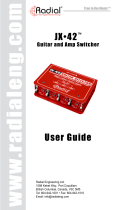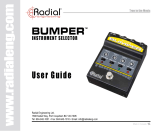
www.radialeng.com
Radial Engineering
1638 Kebet Way, Port Coquitlam BC V3C 5W9
Tel: 604-942-1001 Fax: 604-942-1010
email: [email protected]
True to the Music
Radial Engineering is a division of C•TEC (JP CableTek Electronics Ltd.)
Radial SGI users guide V1.0 - Part #: R870 1115 00
Subject to change without notice
1
2 3
6
54
SGI User Guide
Radial Engineering
RADIAL LIMITED THREE YEAR TRANSFERABLE WARRANTY
Radial Engineering - a division of JP Cabletek Electronics Ltd. war-
rants this product to be free from defects in material and workmanship
to the original owner and will remedy any such defects free of charge
according to the terms of this warranty. Radial Engineering will repair
or replace at its option any defective component(s) of this product,
excluding the nish, the footswitch (footswitch is warranted for 90
days) and wear and tear from normal use, for a period of three (3)
years from the original date of purchase. In the event that a particu-
lar product is no longer available, Radial Engineering reserves the
right to replace the product with a similar product of equal or greater
value. To make a request or claim under this limited warranty, the
product must be returned prepaid in the original shipping container
(or equivalent) to Radial Engineering or to an authorized repair
centre and you must assume the risk of loss or damage. A copy of
the original invoice showing date of purchase and the dealer name
must accompany any request for work to be performed under this
limited warranty. This limited warranty shall not apply if the product
has been damaged due to abuse, misuse, misapplication, accident
or as a result of service or modication by any other than an author-
ized repair centre.
THERE ARE NO EXPRESSED WARRANTIES OTHER THAN
THOSE ON THE FACE HEREOF AND DESCRIBED ABOVE. NO
WARRANTIES, WHETHER EXPRESSED OR IMPLIED, INCLUD-
ING BUT NOT LIMITED TO, ANY IMPLIED WARRANTIES OF MER-
CHANTABILITY OR FITNESS FOR A PARTICULAR PURPOSE,
SHALL EXTEND BEYOND THE RESPECTIVE WARRANTY PE-
RIOD DESCRIBED ABOVE OF THREE YEARS.
RADIAL ENGINEERING SHALL NOT BE RESPONSIBLE OR LI-
ABLE FOR ANY SPECIAL, INCIDENTAL OR CONSEQUENTIAL
DAMAGES OR LOSS ARISING FROM THE USE OF THIS PROD-
UCT. THIS WARRANTY GIVES YOU SPECIFIC LEGAL RIGHTS,
AND YOU MAY ALSO HAVE OTHER RIGHTS, WHICH MAY VARY
DEPENDING ON WHERE YOU LIVE.
SGI User Guide
Radial Engineering
1
2
3
4
POWER LED - indicates the SGI
TX is active when power supply
is connected.
DRAG™ - load correction allows
you to dial-in the proper load for
your pickups.
INPUT - ” jack for instrument
connection.
8
7
6
5
RECEIVE - XLR input receives
balanced mic-level signal from
SGI TX unit.
OUTPUT - ” jack outputs guitar
signal.
87
FEATURES AND FUNCTIONS
SGI
STUDIO GUITAR INTERFACE
Users Guide
TRANSMIT - XLR output trans-
mits balanced mic-level signal to
the SGI RX unit.
POWER - connection for in-
cluded 15VDC power supply.
SGI TX
SGI RX
GROUND LIFT - reduces ground
loop hum by disconnecting the
ground path from pin-1 on the
XLR jack.
True to the Music
Part # R800 1600

Congratulations on your purchase of the Radial SGI TX-RX studio guitar inter-
face. The SGI has been designed and constructed to provide years of depend-
able performance whether it is used in the studio or on the road.
Your new SGI features a 100% discreet Class-A signal path to ensure optimum
audio performance and is equipped with transformer isolation to eliminate buzz
and hum caused by ground loops. To further assure sonic integrity, the SGI is
equipped with Radial’s unique Drag™ Control load correction circuit. Drag lets
you apply the perfect load to counteract cable capacitance and buffering to en-
sure the natural tone and dynamics of your instrument are maintained.
Although the SGI is ‘plug & play’ easy to use, we recommend that you take a few
minutes to read this short manual so that you get the most out of your Radial SGI.
Should you have any questions that are not covered in this manual, we invite
you to log onto www.radialeng.com and visit the FAQ section on our site. This is
where we post the latest updates and applications from users like you.
Now get out there and play guitar with your amp on the other side of the lake!
INTRODUCTION
The Radial SGI studio guitar interface is delivered as a transmit TX and receive
RX set that is connected together with a standard balanced twisted pair XLR
microphone cable.
The SGI TX (or transmit module) is active buffered meaning that it requires power
to drive the signal. A high output 15VDC power supply is employed to power the
Class-A audio path and provides the horsepower to drive the signal. The SGI-RX
(or receive module) is passive. This means that it does not require any power.
The SGI is designed to transmit high impedance guitar signals to 100 meters
(330 feet) and beyond . With these distances in mind, it is likely that each end
will be connected to equipment that will in turn, be powered by different electrical
circuits. To alleviate noise problems caused by potential ground loops, the SGI
is equipped with isolation transformers at each end that have been matched and
counter-wired to offset any artifact.
The bright yellow nish increases visibility to make nding each end as easy as
possible, while construction is 14 gauge steel and features welded I-beam con-
struction to eliminate potential stress on the PC board.
SGI User Guide
Radial Engineering
SGI User Guide
Radial Engineering
SGI User Guide
Radial Engineering
USING THE SGI
As always, before making any audio connection, ensure audio system power
is off and volume controls are turned down. This practice eliminates popping
caused by power-up transients that could damage loudspeakers or other
components.
Begin by connecting your instrument to the SGI-TX, an XLR cable between
the TX and RX module, and the RX module to your guitar amp or pedals. You
can now connect the 15VDC power supply to the SGI-TX module. There is no
power switch. As soon as you connect the supply the LED should illuminate
telling you power is on.
Although the SGI has been optimized for guitar, you can use it with any high-
impedance instrument. Just be careful with high output devices such as key-
boards, as these could overload the input if driven too hard. If you intend to
use your SGI with high output instruments, simply listen to the signal to make
sure it is clean and distortion free. If you hear distortion, it is likely the keyboard
signal is too hot. Turn it down and you should be set to go.
The Radial SGI-RX is passive. The only control on the RX is a ground lift. This
lifts pin-1 ground on the XLR receive and is used to further eliminate ground
loops should hum or buss be encountered.
DRAG™ CONTROL
The Radial SGI-TX is equipped with a recessed knob called Drag control.
This unique load correction circuit allows you to apply a resistive-capacitive
load on your pickup to counteract any effect of the buffering circuit or cable.
It is designed speci cally for passive guitar pickups that are most sensitive to
the input impedance of an ampli er. Drag will have almost no effect on active
devices such as keyboards.
For best results, we suggest that you start with a clean tone and set the Drag
control to 50% or 12 o’clock and then adjust to suit. More drag will result in a
darker tone, while less drag will reduce the load on the pickup and add spar-
kle. Simply nd the setting that you like using a guitar pick as a screwdriver
and you are set. Drag control is subtle yet very musical.
You are now set to go!
FAQ
Can I use the SGI as a re-amping device?
No. The Radial SGI employs a proprietary balanced signal between the
TX transmit module and the RX receive module, making in unsuitable for
typical line-level signals.
Can I use other instruments such as a keyboard or even voice
through the SGI?
Yes. Just make sure you do not overload the input as this will cause
distortion. Keep in mind that the SGI is designed for guitar levels. Key-
boards and line-level outputs are signi cantly more powerful and should
be attenuated.
Why is the SGI bright yellow?
So you will be able to nd the other end! Many studios are out tted with
a labyrinth of connector panels and the SGI can easily be left in one place
or another. Bumble bee yellow should make tracking the SGI easy!
Does the Drag control have any effect on active pickups?
You will hear very little effect, if any, when using active instruments, as
their buffered outputs will generally not be affected by an added load. The
SGI’s Drag control is really designed to affect passive electric guitars.
Can I connect effect pedals between the SGI and my guitar amp?
Yes of course! The SGI will work just like your guitar, except you will be
able to play your amp several hundred feet away.
Can I use the SGI on a large stage to drive my amp?
Yes. Although we have other products in our Tonebone range such as
the Switchbone and Loopbone that can do this very well for distances
up to 50 feet.
Could the SGI cause noise or cross talk in a live touring snake
system?
The SGI is completely analogue and is low level. You should not encoun-
ter any of these problems using the SGI.
SGI TX
SGI RX
SGI with Off-stage Wireless Systems
SGI with Off-Stage Amps SGI in the Studio
300’ XLR Mic Cable or Snake
100 ft.
75 ft.
/








